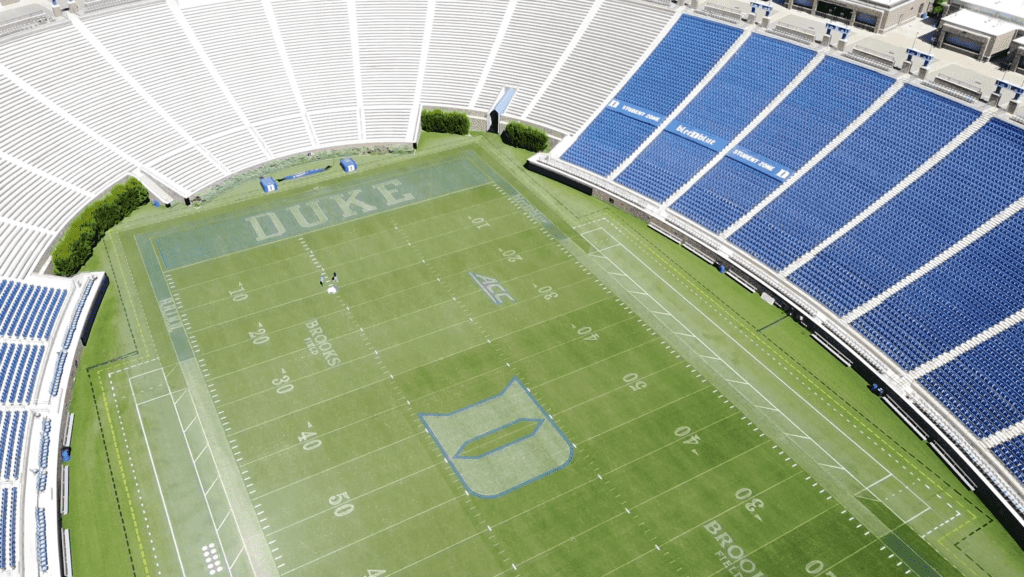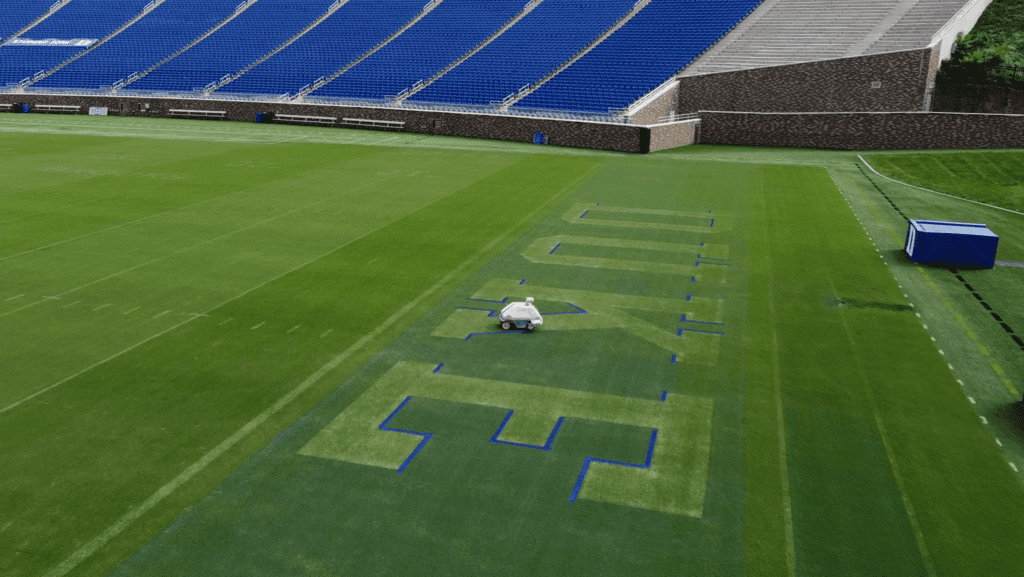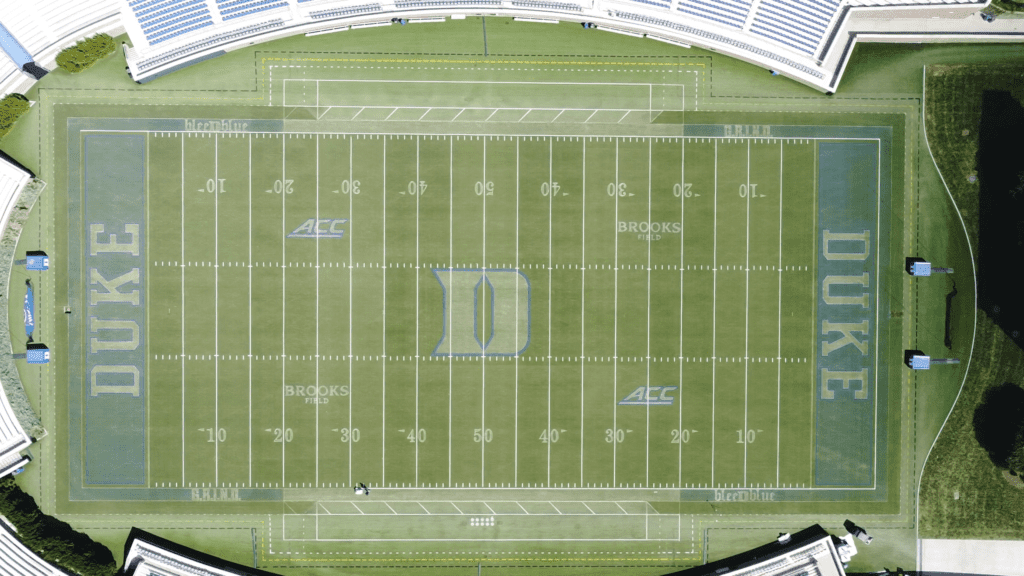Duke University is one of the top institutions of higher learning in the United States. As one of the world’s leading research universities, its reputation for excellence in education is matched only by its powerful NCAA Division I athletics program.
THE CHALLENGE
For an NCAA Division I athletics program the expectations are high and the sports facilities too have to reflect that level of excellency. However, maintaining the athletic fields in pristine condition year-round proved to be challenging as manual marking became a laborious and time-consuming task.
THE SOLUTION
The University decided to look into more efficient solutions to maintain their fields, without sacrificing the quality, and so in 2020 they automated their line marking operations with their own Turf Tank Robot.
A more efficient way of painting fields
Ian Christie is the Superintendent at Duke University and the one who’s been using the robot to mark the fields for the past three years. When asked about the main driver that pushed them to switch from traditional line marking methods to robotics solutions he explains:
Being here at Duke, I think we’re always trying to look for cutting edge ways of doing things, trying to be the best of the best. I think that’s the reputation that we have, and that we are always going to strive for.
Ian Christie, Superintendent
And the Turf Tank robot proved to be the cutting-edge technology that completely transformed their line marking operations.
According to Ian, there are several advantages of having a line-marking robot, but chief among them is the increased efficiency. In the past, it would take a team of three people 10 hours every week to paint a football field, with the level of detail and precision that was desired. This process entailed dragging string and carrying hash mark stencils around the entire field. Now, that same field can be painted by just one person using a tablet, operating the Turf Tank, and the field is ready in six hours.

The Turf Tank has helped us immensely to be more efficient and have greater results as well!
Ian Christie, Superintendent
This is all thanks to the robot’s autonomous design. Once the user sets it up, the robot will paint the field all by itself, without human intervention. So with the time the crew now saves, they are free to focus on other tasks around the facility.
“It allows that flexibility that you don’t have to be locked in. The field is going to get painted, regardless of whether you’re staring at it or not. That robot is doing what it needs to do. A lot of times I’m answering emails while it’s going or I’m making schedules, doing some paperwork.”
This extra time might also be spent on giving the fields a little more attention and making sure they are in top condition, tasks that were frequently overlooked in the past due to a lack of time.
“So we can try to get to the details a lot more frequently than we would have otherwise, because we were too busy painting.”
Efficiency without compromising quality
When it comes to painting a field in the traditional manner, speed and quality are not compatible concepts. But with the Turf Tank robot, that mix has become a reality for the crew at Duke University, who can be at ease of mind that they can be efficient, without sacrificing the quality of the fields.
At a major university, the brightness, the straightness, everything matters and definitely doesn’t go unnoticed with the Turf Tank. It’s been phenomenal for us.
Ian Christie, Superintendent

“We love the straightness, the measurements are dead on. I have no fears whatsoever. I think being GPS-guided, the accuracy is far better than anything in the sports turf world.”
“You stand back and you see the results. Everything is square, your edges are straight. People are blown away by the results. And combine that with no one’s walking by it. It’s incredible.”
The robot’s GPS technology not only ensures that Duke University has precise lines with every marking, but it also has a positive impact on the health of the grass. As Ian explains: “paint is not good for grass, regardless of the brand, so anytime you can let the paint grow out is better for your field.”.
With the robot’s GPS technology the lines from the initial marking are saved in the software, so the robot will know their exact position the next time it needs to go out and repaint. That means that the grounds crew do not have to worry anymore about the lines fading out and repaint them every week, just to ensure they do not lose their spot, even though the fields might not even be used.
“The Turf Tank allows us to not have to repaint only to prevent us from re-measuring things. So we can let fields grow out and move fields as needed. We could re-stencil right where they need to go. It allows the field to get a break from the constant painting.”
More flexibility
The excellency that characterizes the University can be seen among its employees as well. Ian is a super-user of the Turf Tank Robot, continuously curious to push the limits of technology and always happy to try new projects with the robot. So he is always excited to get requests for different logos for different special occasions.
Ever since we got the robot, we’ve gotten requests for different logos, different fields…a wide range of requests. The answer is always yes, we can! Or we will find a way to do it.
Ian Christie, Superintendent
“The sky’s the limit of what we can do”
Traditionally, to be able to display all of these logos, they would need to make bespoke stencils for each situation. However, because stencils may be costly and the main drawback is that their size is predetermined, Turf Tank Robot’s ability to scale the logo according to location and space availability, is a significant benefit.
This flexibility is a great benefit when it comes to the coaches’ expectations, too. As Ian explains, “the coaching world is always changing. So we have to keep up with them and their needs. Because that’s our job on a daily basis. To give them what they need.”
“We have about 13 different fields across campus, half of them artificial, half of them natural grass. We do Ultimate Frisbee, rugby, baseball, softball, football, soccer, field hockey, you name it, we have it, whether it be a varsity sport or recreation sport. The Turf tank allows us to have different camps, different layouts.”
“One of the great things I like about the Turf Tank is the customizability of it. It allows the user to do what you need it to do. If you need to save paint, you can go fast and change the nozzles or you have a TV game, you can be brighter and slow it down. It allows you to just as a user, do what you want it to do.”

Conclusion
Ian closes his story with advice for all those in charge of maintaining sports facilities:
“I do recommend the robot to anyone, because there is a wide range of capabilities that it can do. And everyone, clients across the world have different needs. And I think the robot can really hit on any specific need. Some people want to save paint, it can save paint, can save labor can save a lot of different things. But you as a user have to tell it what to do. And I think that’s the advantage of it. It really has endless opportunities in it.”



